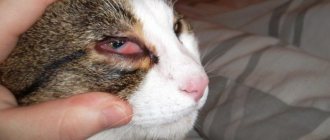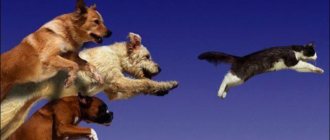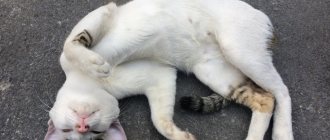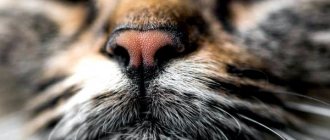People told fairy tales about the feud between cats and dogs, and it was immortalized in proverbs and sayings. There is a whole series of paintings in which cats and dogs are depicted at the moment of a fight or tense neutrality. French artist of the early 18th century. Alexandre-François Deporte, working in the then fashionable manner of animalism, painted paintings under telling titles: “A Dog Fighting with a Cat in the Kitchen” and “A Dog Protecting Hunting Trophies from a Cat”, “A Girl with a Dog and a Cat”. Are cats afraid of dogs or does their enmity have slightly different motives?
Why does fear arise?
Pet owners often cannot understand a dog that is afraid of a cat, avoiding communication with it in every possible way. They think this behavior is stupid. However, it is important for owners to understand the pet’s feelings. And try to make his living together with the cat as comfortable as possible. The correct actions of the owner sometimes even help pets become good friends.
The fear that a dog experiences in front of a cat can be explained by various reasons. Animals, like people, are afraid of everything unknown. A dog that has never dealt with cats may experience fear when encountering a domestic tiger.
This feeling is especially typical for a pet with a low level of socialization, a tendency to anxiety and restlessness.
Family matters: Andrei Arshavin’s mother is suing his ex-wife
Seychelles opened borders: entry rules for Russians
Forgiving your ill-wishers is an indicator of strength: a parable that teaches this
The cause of fear may be the dog's personality traits. Some animals have a shy disposition. It is difficult for them to establish contact with other representatives of the fauna.
The most common cause of fear is a negative experience with a cat. If a domestic tiger behaved aggressively towards a dog, the dog may become seriously frightened when meeting its relatives. Avoiding contact with the animal is a defense mechanism in this case. This is how the dog seeks to protect itself from repeating negative experiences.
Why do dogs chase cats?
To stop your dog from chasing cats on the street, be patient. This habit is inherent in nature, especially among representatives of hunting breeds. Dogs, experiencing the hunting instinct, simply cannot resist it.
Unfortunately, it will take more time to wean an adult dog from this harmful habit, so it is worth properly socializing your pet and instilling useful behavioral skills in it at an early age.
Important! A dog, regardless of age and breed, must unquestioningly follow commands, which is achieved through systematic exercise and training.
At home and on the street, the dog must behave well, react adequately to relatives and other animals, so as not to cause problems for the owner and people around him. When chasing a cat, it is almost impossible to control the dog. Carried away and succumbing to the hunting instinct, the dog rushes headlong after his “prey.” For him, nothing and no one around exists. Just a cat running away.
- In this way, dogs assert themselves and increase their self-esteem. By chasing the “victim”, the dog shows dominance, shows its strength and advantage.
- Representatives of hunting breeds chase cats for fun. For example, terriers, setters, spaniels, sighthounds, hounds, and greyhounds react sharply not only to cats, but also to any moving objects.
- Dogs' dislike of cats can also be caused by a puppy or adult dog being scratched by a cat or a cat guarding its offspring or territory. Dogs remember their offenders for a long time, study their behavior, and at any opportunity, sooner or later they will take revenge. Only a completely innocent animal, or worse, a small defenseless kitten, can suffer.
The best way to overcome fear
It is about allowing the dog to have a positive experience with the cat. To do this, the owner needs to be patient. It should be taken into account that socialization in a dog occurs between the ages of seven and fifteen weeks. During this time, the puppy develops ideas about the world around him. This includes developing a feeling of fear. If at this time the puppy gains positive experience with cats, it will be easier for him to establish harmonious relationships with these animals in the future.
If a domestic tiger frightens a cub, the fear will persist for a long time. It is better for owners to get a cat at a time when the dog has not yet reached adulthood. But what to do if an adult dog began to feel afraid when a small tiger had already appeared in the house?
What does the third wife of the star of the series “Ivanov-Ivanov” look like: new photos of Louise
Deceivers themselves most often fall for misinformation.
What offense did Alexandra Ursulyak not forgive her first husband and filed for divorce?
Adult animals
Everything is more complicated here. Either separate the animals into different rooms, or have only one pet. There are dogs that are kind at the genetic level: they are ready to communicate with everyone, but such cases are rare, and the same applies to felines.
When you first meet, keep the dog muzzled and on a short leash, and place the cat in the highest place in the house.
Try spending a few minutes together every day.
If the dog nevertheless rushes, tie the dog nearby, give the command “sit”, approach the cat and pet it to relieve fear and tension. Then go up to the dog and pet him too.
Source
How can an owner help a frightened dog?
Firstly, the owner should not encourage the animal's fear. There is no need to calm your dog down with hugs or treats. This behavior seems quite logical to people. However, at the same time, the dog develops the wrong idea that fear is a good way to receive affection or food from the owner.
Instead of reassuring the dog every time he shows fear, the owner should try to reduce the dog's anxiety level. To do this, you can consult a dog handler. The specialist will select the appropriate methods that will suit a particular dog, taking into account its individual characteristics and the current situation.
Calming agents will help reduce your four-legged friend's fear of the cat. They will allow the dog to maintain composure when interacting with the “neighbor” and strengthen mutual trust between the pets. However, before using such products, the owner should consult a veterinarian.
When a new inhabitant appears in the house where the dog lives, the owners need to help the pet get used to the “neighbor”.
The owner should spend more time next to the dog and give it enough attention. It is important to take care of the comfort and safety of your four-legged friend. If your dog acts too restless in the presence of a cat, it is better to keep him on a leash. When the dog adapts a little to the situation and begins to show more confidence, the owner can allow him to carefully examine and smell his new “neighbor”.
What is the reason for the strained relationship?
Zoologists say that cats are not afraid of dogs, but avoid unnecessary contact. Dogs crave companionship. Cats, on the contrary, walk on their own, they require personal space, and they do not like it when someone violates it.
A dog may approach a cat out of curiosity, but the first meeting is unlikely to end in friendship. Murka will either run away or try to scratch the poor dog. If the cat runs, it will provoke the dog to play chase; if it starts to hiss and scratch, it will cause a defensive reaction, which will lead to fear or aggression.
After the first unsuccessful attempt at acquaintance, a cat and a dog may never become friends. Therefore, it is important to conduct the first meeting of pets correctly and avoid mistakes.
When is specialist help needed?
If the dog is experiencing severe fear, and the owner is not sure that he can cope with the problem, it is better to contact an animal psychologist, veterinarian or dog handler. The same applies to situations where the dog’s behavior poses a threat to its health or the safety of others. If the fear is too strong, a specialist may recommend medications with a calming effect for your pet.
Fear of a cat is not a problem that a dog owner can solve in one day.
This situation requires endurance and diligence. But if the owner behaves correctly and, if necessary, seeks help from an expert, the fear disappears. The dog feels comfortable, gains a positive experience of communicating with the cat, and the pets live in complete harmony with each other.
Found a violation? Report content
Misunderstanding Signals
Scientists believe that the main reason for misunderstanding is differences in the perception of communication signals. Animals communicate with each other using postures, glances, and body movements. But the different signals of cats have diametrically opposite meanings in dogs and vice versa. According to research:
- A dog is a pack animal and lives side by side with a person much longer. So the dog sees the whole world through the prism of the “pack”. The dog is used to expressing his emotions violently, brightly, demonstratively.
- The cat is an individualist, accustomed to avoiding strangers and not making close contact without its own desire. A calm, reserved cat is obviously irritated by the dog’s jumps and attacks, and she tries to avoid communication by hiding in a tree or running away from her annoying counterpart.
- A cat leaving at a “fast gallop” awakens the hunting instinct in the dog, and it will certainly chase the “prey.” One incident is enough, and the negative experience will be firmly entrenched in the animal’s memory. At the same time, the dog may not experience aggression - for him this is a game. A cat sitting on a tree perceives the situation completely differently. For her, a barking dog represents the enemy and danger.
Different meanings of the same gestures . The cat and the dog “speak different languages”:
- Tail wagging: in dogs it means affection, pleasure, disposition. In a cat, this is a sign of extreme nervousness, irritability, dissatisfaction, and readiness to attack.
- Ears raised and directed forward: in cats this is a sign of sympathy, disposition, and a calm state, and in dogs it is alertness, extreme attention, and readiness for action.
- Closed mouth: in cats it means relaxation, in dogs it means tension.
- Lying on its back: the dog shows complete trust by exposing the most unprotected place - the stomach. The cat also rolls over onto its back in order to attack the attacker with the strong claws of its muscular hind legs.
- Ears pressed to the head: in dogs it can mean both a feeling of guilt, humility, and a feeling of joy, impatience. A cat presses its ears before an attack or from severe fright (read more about why a cat presses its ears).
Clinical researches. Animal psychologists have been studying cats and dogs for a long time. In practice it was found that:
- The language of a cat and a dog is so different due to the fact that the dog is a pack animal. His “tongue” is designed for close contact. Dogs are accustomed to “reading” small signs, they learn to live peacefully in a pack, protect each other and act together. There is a clear hierarchy in the pack, and domestic dogs get used to obeying the “leader” - the owner.
- The signals of a solitary cat are more designed to keep other cats away. Cats do not have submission signals like dogs. If the cat failed to scare the enemy, then it will strive to avoid a critical situation without leading it to a bloody conflict. “Distant” signals in cats are marks whose smell carries far away. The cat’s sensitive nose “reads” these signs at a considerable distance, and if the animal does not want conflict, then it avoids someone else’s territory. Dogs are tuned to close contact, and this is perceived by the cat as aggression - the “enemy” ignored the prohibitory marks, invaded the territory and came too close, disturbing the peace with noisy behavior.
Legends and myths
There are a huge number of legends and myths about the feud between dogs and cats. The most popular is a Chinese folk tale.
According to legend, a dog saves a girl, who turns out to be a princess. To thank the dog, the king issues a decree in which he promises each dog a home and plenty of food. To spread the news, a scroll containing the king's will is tied to the savior's tail.
The dogs decided to have a feast, and so that the decree would not be lost, they gave it to the cat for safekeeping. When in the morning the dogs wanted to return the valuable document, it turned out that it was lost. The cat, in turn, claimed that mice had stolen it.
The dogs did not believe the cat and attacked her to punish the culprit. Since then, it has become a tradition that dogs hate cats, and the latter are at enmity with mice.











